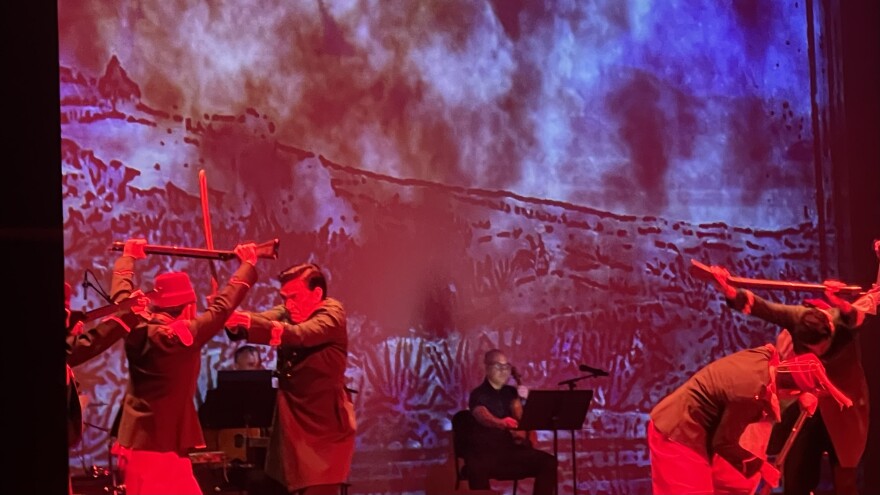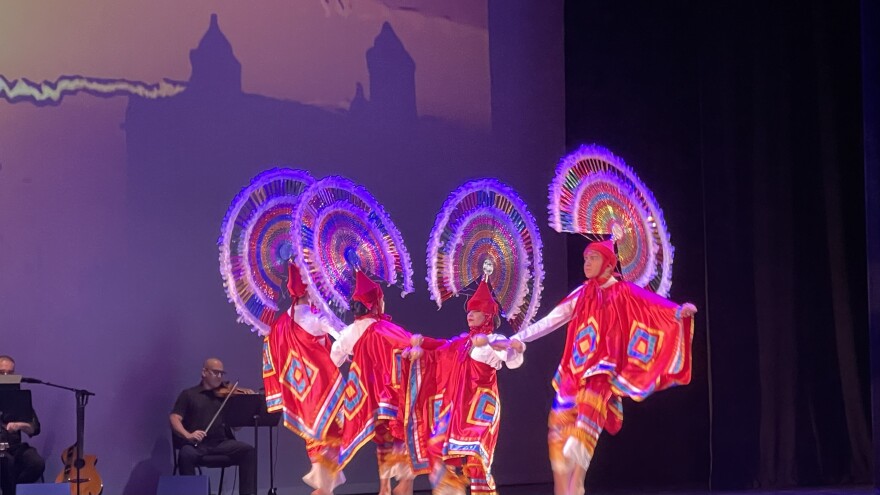BETHLEHEM, Pa. — Dressed as soldados, or soldiers, Calpulli Dance Mexican Company members were armed with prop rifles and machetes.
A re-enactment of the Battle of Puebla had begun, and the thousands seated in the audience erupted in cheers when it was revealed that the Mexican army had declared victory against the French.
History tells us the victory happened on May 5, 1862, which is now celebrated worldwide as Cinco de Mayo.

The recreation was part of Calpulli Mexican Dance Company's “Puebla: The Story of Cinco de Mayo” at Zoellner Arts Center on Friday.
Students from seven schools in Lehigh and Northampton counties and seniors from the Lehigh Valley Hispanic Center and Arden Courts in Easton were invited to the performance.
It was meant to showcase the historical events and culture of the Puebla region — less than a two-hour drive from Mexico City, the country's federal district and cultural hub.
Story of the natives
The Calpulli Mexican Dance Company comprises 20 dancers and 14 core musicians and offers educational programs and performances for all ages.
While in town, the nonprofit, based in New York City, visited with seniors at the Hispanic Center Lehigh Valley and students from Broughal Middle School on Thursday.
It will perform at a ticketed show at 7:30 p.m. Friday at Zoellner.
"Maybe through our work, there's a split second where you think about it: 'Hey, that's a story about an underdog from a native community in Mexico.'"Calpulli Mexican Dance Company founder Juan Castańo
The company was founded by longtime collaborators Juan Castańo and Alberto López Herrera in 2003.
Both artists are Mexican: Castańo grew up in El Paso, Texas, 1,200 miles from López Herrera's hometown of Puebla.
The pair met in 2000 when they were members of another dance group, Ballet Folklórico Mexicano Nueva York.
For the first decade, the company would perform traditional Mexican folk dance.
Still, as they began to learn, many in their audiences knew little about historical events in Mexico, such as Cinco de Mayo and Día de los Muertos, which now are celebrated worldwide.
"Cinco de Mayo is sort of like St. Patrick's Day of Mexico, right?" Castańo said. "So our perspective was that in the U.S., much attention is going into Cinco de Mayo.
"We've done the morning shows, with the guacamole and the margarita. So great, have your margarita for Cinco de Mayo.
"But then maybe through our work, there's a split second where you think about it: 'Hey, that's a story about an underdog from a native community in Mexico.'"

Universal message
Along with the "Puebla" show, Capulli has four other stories in its repertoire (López says they are working on a fifth).
"We think that stories are a way for audiences of all backgrounds to hook into our performances. Even if you don't understand the nuances of Mexican culture or the tradition here and there, through a story you can hook on to a universal message."Calpulli Mexican Dance Company founder Juan Castańo
"We think that stories are a way for audiences of all backgrounds to hook into our performances," Castańo said.
"Even if you don't understand the nuances of Mexican culture or the tradition here and there, through a story you can hook onto a universal message."
All the dances are accompanied by music and honor their indigenous ancestry (Calpulli means "large house" in Nahuatl, the language spoken by Aztecs).
Before each act, the cast members introduced the parts, part of Calpulli's educational program.
During one part, as the crowd clapped along to the music, dancers wore large circular headdresses (meant to represent the sun) as they performed the "Danza de los Quetzales" while introducing Benito Juarez, the first president of Mexico, and the leader in the Battle of Puebla.
In another act, the "Danza de los Negritos," native to the Totonac people of Puebla, a healer, known as maringuilla, performed an African healing ritual (brought to Mexico by African slaves) to heal a wounded solider.
Ballet elements, connecting cultures
Many "ooohs" and "ahhs" were in the audience as a soldier said goodbye to his wife during a loving, choreographed ballet.
Local ballet performer Emeline Nebzydoski, among hundreds of Northeast Middle School students in attendance, said she was impressed with the show.
"It was amazing," Nebzydoski said. "I could relate to some of the moves, which was nice. I thought the dancers were magnificent.
"One of the things I appreciated was that the kids were told what to expect next, I thought that was educational. It wasn't overdone and had just the right amount of information."Northeast Middle School teacher Adam Soto
One of her teachers, Northeast Middle School's Adam Soto, also was impressed.
"One of the things I appreciated was that the kids were told what to expect next, I thought that was educational," Soto said. "It wasn't overdone and had just the right amount of information."
Before preparing for the evening show, members of Calpulli met with some of the ESL program students and their families from Southern Lehigh School District.
"We used this as a family engagement activity, so we try to find things that match with heritage," Northern Lehigh School District Assistant Superintendent Tania Stoker said.
"We have many Hispanic families in our ESL program and Spanish-speaking families who tend to like many of the programs that Zoellner [Arts Center] runs because either they are bilingual or it speaks to their heritage."
The youth's reaction brought smiles to the faces of Calpulli's cast (López shared a story of running into a student years later on a New York City subway who remembered seeing the show).
"It's beautiful when the students and teachers tell us about what they've learned," Castańo said.
"I've had teachers tell us they thought Cinco de Mayo was Mexican Independence Day, and other students tell us that their parents were from Puebla [Mexico] and they never knew about the history."


